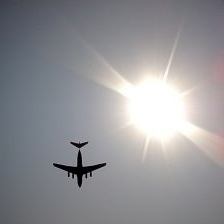Travel News
Despite O’Hare Near-Miss, Airlines Balk At Paying For Air Traffic Upgrades
 Just days after the Department of Transportation (DOT) investigator general admitted the agency isn’t sure why air traffic controller errors have soared in the past year, two planes nearly collided at a major airport.
Just days after the Department of Transportation (DOT) investigator general admitted the agency isn’t sure why air traffic controller errors have soared in the past year, two planes nearly collided at a major airport.
On Monday two passenger planes came within 300 feet of colliding at Chicago’s O’Hare International Airport.
According to air traffic recordings, a controller supervisor prevented a collision by mere seconds when he ordered a SkyWest Airline jet to abort its landing to allow an ExpressJet Airlines plane, which was taxiing down the runway, to takeoff.
This incident occurred just minutes after Vice President Joe Biden landed in O’Hare, though Air Force Two, the Vice President’s plane, was never in danger.
Both the National Transportation Safety Board (NTSB) and the Federal Aviation Administration (FAA) are investigating this event.
The DOT and the FAA are also investigating the cause of the vast increase in controller errors.
On Thursday, DOT Investigator General Calvin Scovel told a Senate subcommittee that the FAA has placed many inexperienced controllers at some of the nation’s busiest and most complex air traffic facilities.
In 2004, 15 percent of all controllers were in training. As of March 2011, 25 percent of all controllers are now in training. Scovel testified that at LaGuardia Airport in New York, trainees comprise 39 percent of the work force.
Learn more: Air Traffic Controller Mistakes Double As Serious Safety Incidents Reported
Inexperience might not be the sole cause in the staggering rise of reported errors.
 FAA Administrator Randy Babbitt told the Senate subcommittee that a new voluntary program that encourages controllers to report mistakes without fear of reprisal has contributed to the rise of reported errors.
FAA Administrator Randy Babbitt told the Senate subcommittee that a new voluntary program that encourages controllers to report mistakes without fear of reprisal has contributed to the rise of reported errors.
In addition, new radar technology allows the FAA to identify more instances of planes coming too close together, instances that were previously unnoticed.
In a proposed new contract between FAA and the National Air Traffic Controllers Association, there would be financial incentives for experienced controllers who work at the larger airport hubs.
However, this week, the FAA’s NextGen plan hit a roadblock. The plan aims to improve the current ground-based air-traffic control system, which has been around since the 1950s, by replacing it with satellite-based tracking technology. GPS-assisted aircraft could fly closer together, react faster to changing flight conditions and optimize landing approaches.
The system, estimated to cost $40 billion, is only partially installed. Airline executives are unwilling to buy additional cockpit gear for the program, which they claim isn’t delivering on its promise.
In a conference call with reporters, Delta Chief Executive Richard Anderson said, “Many carriers––Delta, Southwest, American, United––have all made significant investments in equipage for our existing fleets that we are not using. We want to leverage the technology we have today before we add more technology and more cost.”
By Lily J. Kosner for PeterGreenberg.com.
Sources: Washington Post, USA Today, MSNBC, Fox Business, Marketwatch
Related articles on PeterGreenberg.com
- Air Travel News – Airlines & Airports section
- Air Traffic Controller Mistakes Double As Serious Safety Incidents Reported
- What Does It Take To Be An Air Traffic Controller?
- FAA’s Chief Air Traffic Control Officer Resigns In Wake Of Sleeping Controller Scandals
- Air Traffic Control Staffing Concerns & Frequent-Flier Face-Lifts
- Washington’s Reagan National Airport Air Traffic Controller Allegedly Falls Asleep, Putting Planes At Risk












